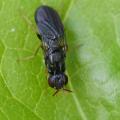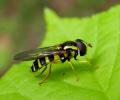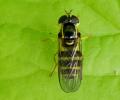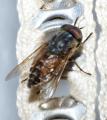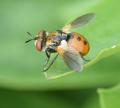|
Another fly... of Viseu
|
|
| jorgemotalmeida |
Posted on 14-06-2006 00:17
|
|
Member Location: Posts: 9295 Joined: 05.06.06 |
Abdomen reduced... ID please.. Edited by jorgemotalmeida on 14-06-2006 00:35 |
|
|
|
| Kahis |
Posted on 14-06-2006 07:50
|
|
Member Location: Posts: 1999 Joined: 02.09.04 |
Hmm. Tough call between Fannia (Fannidae) and Anthomyiidae. I would say Fannia.
Kahis |
|
|
|
| jorgemotalmeida |
Posted on 14-06-2006 10:37
|
|
Member Location: Posts: 9295 Joined: 05.06.06 |
Kahis wrote: Hmm. Tough call between Fannia (Fannidae) and Anthomyiidae. I would say Fannia. Why in Diptera Gallery doesn?t appear the Fannidae family? |
|
|
|
| Kahis |
Posted on 14-06-2006 10:42
|
|
Member Location: Posts: 1999 Joined: 02.09.04 |
Perhaps because they are 1. mostly very boooring and 2. often very active and difficult to shoot 
Kahis |
|
|
|
| diphascon |
Posted on 14-06-2006 10:54
|
|
Member Location: Posts: 85 Joined: 26.07.05 |
Kahis wrote: Perhaps because they are 1. mostly very boooring ... ... and you say such things now that I have purchased a copy of "The European Fanniidae" !!!  Really, 82 species, of these 79 genus Fannia ... at first sight it looks like the larvae are morphologically more diverse than the adults. cheers - martin |
|
|
|
| jorgemotalmeida |
Posted on 14-06-2006 11:25
|
|
Member Location: Posts: 9295 Joined: 05.06.06 |
Kahis wrote: Hmm. Tough call between Fannia (Fannidae) and Anthomyiidae. I would say Fannia. Please try to tell me how can I distinguish between Fannidae and Anthomyiidae using this photo I took. Really this fly was one of the most difficult to photograph. Always moving (almost)  |
|
|
|
| Kahis |
Posted on 14-06-2006 12:08
|
|
Member Location: Posts: 1999 Joined: 02.09.04 |
In this case I had to rely mostly on intuition. Unfortunately the best character (shape of 2nd anal vein on wing) does not photograph well in the field. It is not seen in this photo. The only somewhat useful character visible is setae of hind tibia. Fannidae have two dorsal setae (a preapical near the distal end and a mid-dorsal) and normally few other setae on the upper side of the 3rd tibia. Anthomyiidae do normally have a richer chaetotaxy with several anterodorsals and posterodorsals. In general Anthomyiids have longer and more setae and hairs on the body than Fannidae. The moderately flattened abdomen with smoothy rounded margins is common to all (?) male Fannidae. Male anthomyiids are usually wither less flattened (cylindrical) or strongly flattened with conpicuous male terminalia. With some experience male fannids are easily identified to genus level in the fields. I find females more difficult as some smallish muscidae (Thricopus, Hydrotaea, Hebecnema) closely resemble female fannids in body form and color. Under a microscope these cause no problem. Kahis |
|
|
|
| Robert Nash |
Posted on 14-06-2006 13:32
|
|
Member Location: Posts: 288 Joined: 11.11.05 |
These are very difficult flies to identify without specimens (and sometimes with them, preferably pinned) but to add to Kahis? characters in Fanniidae- the head is hemispherical ; the arista bare; the middle tibia in the males of some species have a strange structure which may look like deformity. In others bent spurs or thorns point down from the mid coxae. Females are more difficult but there are two strong (big) upper fronto-orbitals outside the row of frontals. Another pointer- I picked up on the odd pale yellow-brown of the abdomen contrasting with the pale grey thorax. Several common Fannids (eg. F. fuscula) have this appearance (basal only in F. canicularis). A field character helps . Males swarm beneath tree branches in a zig-zag manner very like that of the house species Fannia canicularis (lesser house fly). When two flies meet they rapidly turn darting apart. Characters separating the small Muscidae Kahis mentions Thricops see Kahis comments on the Gallery pic of Thricops semicinereus then note the dorso-ventally (see glossary) flattened abdomen of your pic of cf. Fannia. Hydrotaea. In males of some species the fore femora are strangely ?deformed? or with odd structure and sometimes the fore tibiae (not mid as in Fannia); females have crossed bristles on the frons and there are two not three sternopleural bristles. Hydrotaea also hover but may be attracted to sweat causing irritation (hence the name Hydrotaea irritans). Hebecnema. Wings smoky or brownish-black which in the sun can seem very black against a light background. http://www.entomologieforensique.ch/page2.htm for a good Fannia pic although not the legs. Hydrotaea ignava is less good and again the legs are not seen. A problem group? I wrote this some years back. ?The identification of Fanniidae and Muscidae is best accomplished by a judicious use of the following keys, swapping one for another if difficulties are encountered:Fonseca (1965), Seguy (1923) and a series of keys to genera by Collin and Ringdahl. A good deal depends on the proper interpretation of bristle characters especially of the legs. A most important point is emitted from all current key works... the leg (femur and tibia) flexes in the posterodorsal plane: once this is understood no further problems should be encountered excepting with flies from alcohol traps which lose their characteristic patterns or tessellations. To properly place Fanniidae and Muscidae Unwin (1983) is most useful.? More keys are available now but the older literature helps sometimes. However this is not identification. It is just getting an answer from a key. In my experience except where a specialist has identified the material most museum specimens even in major institutions are misidentified. Tough call indeed Robert |
|
|
|
| jorgemotalmeida |
Posted on 15-06-2006 00:55
|
|
Member Location: Posts: 9295 Joined: 05.06.06 |
Robert Nash wrote: These are very difficult flies to identify without specimens (and sometimes with them, preferably pinned) but to add to Kahis? characters in Fanniidae- the head is hemispherical ; the arista bare; the middle tibia in the males of some species have a strange structure which may look like deformity. In others bent spurs or thorns point down from the mid coxae. Females are more difficult but there are two strong (big) upper fronto-orbitals outside the row of frontals. Fanniidae family OR Fannidae family? Which is right? |
|
|
|
| Jan Willem |
Posted on 15-06-2006 06:25
|
|
Member Location: Posts: 2122 Joined: 24.07.04 |
Hi Jorge, Fanniidae is the correct family name. Jan Willem |
|
|
|
| Jump to Forum: |


